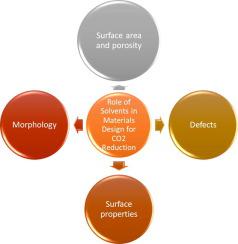Journal of Catalysis ( IF 7.3 ) Pub Date : 2021-10-27 , DOI: 10.1016/j.jcat.2021.10.014 Sehmus Ozden 1, 2, 3 , Laurent Delafontaine 4 , Tristan Asset 4 , Shengyuan Guo 4 , Kai A Filsinger 1, 5 , Rodney D. Priestley 1, 2 , Plamen Atanassov 4 , Craig B. Arnold 1, 3

|
The catalytic reduction of carbon dioxide (CO2) to hydrocarbon fuels offers a tremendous opportunity for a transformational impact on both global energy and environmental sustainability. To enhance the CO2 reduction process, the design and synthesis of novel and efficient catalytic materials with control-over properties are needed. The solvent used in the synthesis of these materials can play a crucial role in tailoring the material properties resulting in changes to their catalytic performance. However, the field still lacks a systematic analysis of the specific effect for different solvents. Here, we report the role of water, ethanol (EtOH), ethylene glycol (EG), Dimethylformamide (DMF), and γ-Butyrolactone (GBL) on the synthesis of reduced graphene oxide (rGO)-copper nanoparticles (CuNP) electrocatalysts used in CO2 reduction reactions (CO2RR). As these solvents contain different terminal groups and molecular sizes, we observed a variation in the d-spacing of the rGO, surface area, nanoparticle yield, and defect density, and characterized the corresponding change in the CO2RR activity. The use of DMF results in higher porosity, d-spacing, yield of CuNP, surface area and defect density which lead to comparatively higher efficiency and selectivity of and selectivity of 19.5 % and 28.4 % for formate and CO, respectively.
中文翻译:

用于二氧化碳还原的石墨烯基催化剂:溶剂在材料设计中的关键作用
将二氧化碳 (CO 2 )催化还原为碳氢燃料为对全球能源和环境可持续性产生变革性影响提供了巨大的机会。提高 CO 2还原过程中,需要设计和合成具有控制性能的新型高效催化材料。用于合成这些材料的溶剂可以在调整材料特性方面发挥关键作用,从而改变其催化性能。然而,该领域仍缺乏对不同溶剂的具体影响的系统分析。在这里,我们报告了水、乙醇 (EtOH)、乙二醇 (EG)、二甲基甲酰胺 (DMF) 和 γ-丁内酯 (GBL) 在合成还原氧化石墨烯 (rGO)-铜纳米粒子 (CuNP) 电催化剂中的作用在 CO 2还原反应 (CO 2RR)。由于这些溶剂含有不同的端基和分子大小,我们观察到 rGO 的 d 间距、表面积、纳米颗粒产量和缺陷密度的变化,并表征了 CO 2 RR 活性的相应变化。DMF 的使用导致更高的孔隙率、d 间距、CuNP 产率、表面积和缺陷密度,从而导致相对较高的效率和选择性,甲酸盐和 CO 的选择性分别为 19.5% 和 28.4%。



























 京公网安备 11010802027423号
京公网安备 11010802027423号